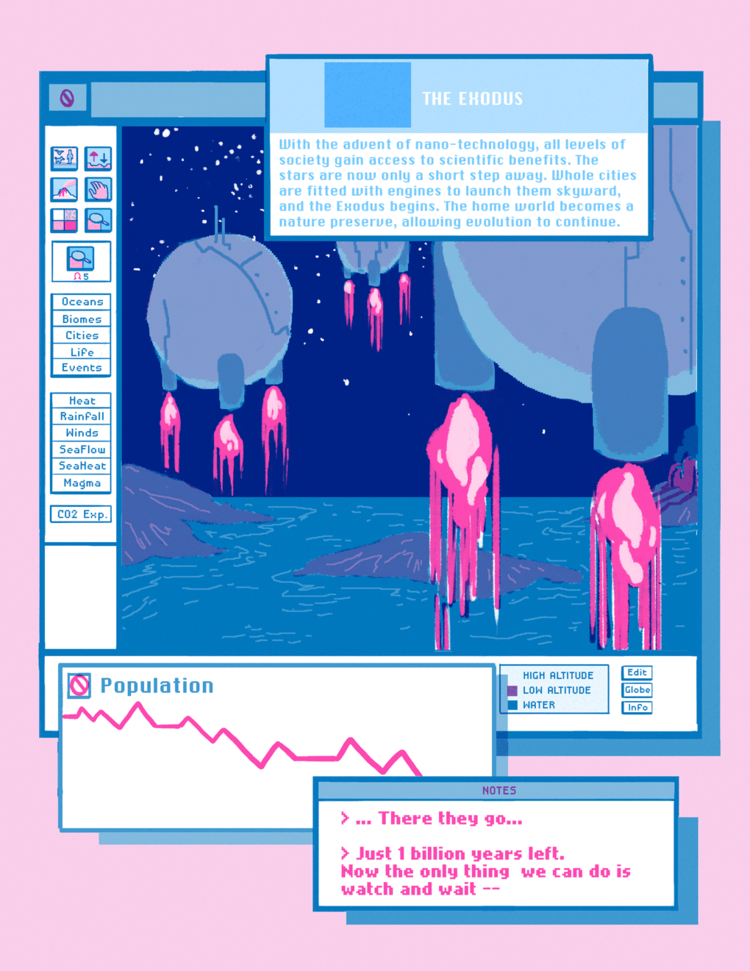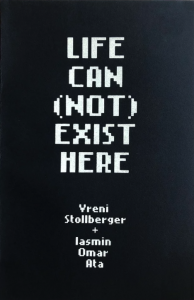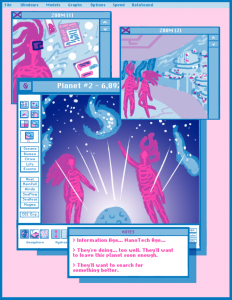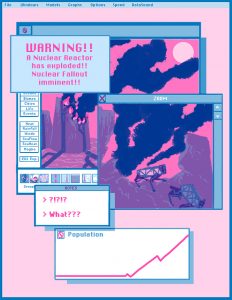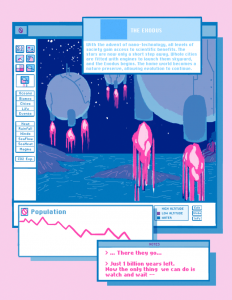Life Can (Not) Exist Here is a collaborative zine self-published in 2016 by Vreni Stollberger & Iasmin Omar Ata. The title is both a wink and nod towards the recent remakes of the Neon Genesis Evangelion film franchise, but the comic is a meditation on the transience and fragility of life.
Life Can (Not) Exist Here is 60 pages; the guts are risoprinted in neon pink and blue, and the cover is thick cardstock with a simple screen printed title. In it, an unseen creator observes a water-covered planet through various screens and dialogues. Notes on the page give the reader a sense of the creator’s thought process. Over the course of the book, creatures spawned on the planet evolve and move through various stages, some of which develop technology allowing them to leave for the stars. At other times, small tweaks to the planet’s internal properties cause massive extinction events, with the creator struggling to right the ship.
The setup and aesthetic of Life Can (Not) Exist Here is all at once striking and familiar. The book closely mirrors turn of the century computer UI, and there’s clearly a nostalgia for that aesthetic at work in this book. Both Omar Ata and Stollberger mention the 1990s MS-DOS game SimEarth as a direct inspiration for making the comic, which is no surprise. Having played other Sim games from that era, the menus and screens look very familiar. But what I find interesting about Life Can (Not) Exist Here is how it communicates time and character. Individual panels in the book communicate observer knowledge, age of the planet, and recorded thoughts in the form of text notes. Those notepad entries are worth examining, since while it’s clear they’re used to communicate to the reader, in the context of the book, they’re essentially the voice of a god talking to themselves. In this small way, Omar Ata and Stollberger are exploring both the power of playing god, but the existential loneliness of godhood and abandonment by the created.
Life Can (Not) Exist Here also has a sense of scale that trends towards systems, but narrows down on individuals throughout the book. Little stories are told in snapshots, and together they form an aggregate history while the creator muses.
As an experimental comic, Life Can (Not) Exist Here defies traditional grids and classic sense of character. The applications of the formal work they’ve done in this book are vast – it’s clear that Omar Ata and Stollberger have only scratched the surface. The use of UI as a narrative tool is one I expect to see fleshed out more thoroughly in the future, but through Life Can (Not) Exist Here, Omar Ata and Stollberger have made a foray into that space that I found compelling.
Sequential State is made possible in part by user subscriptions; you subscribe to the site on Patreon for as little as a dollar a month, and in return, you get additional content; it’s that simple. Your support helps pay cartoonists for illustration work, and helps keep Sequential State independent and ad-free. And if you’re not into monthly subscriptions, you can also now donate to the site on Ko-Fi.com. Thanks!

